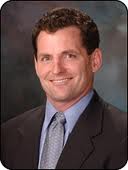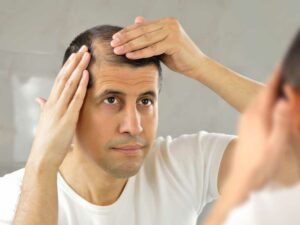 Contact Information for Dr. Paul McAndrews
Contact Information for Dr. Paul McAndrews
(877) 424-7362 / 626-405-1155
http://www.hairgrowthdoctor.com
960 E. Green St., Ste 102
Pasadena, CA 91106
Regrowth: First off, please give us some background about yourself and your practice. What is your medical background and how long have you been practicing?
McAndrews: Dr. Corbett and I are Board-Certified Dermatologists and instructors at USC/LAC Medical Center, teaching the residents the latest advances in the medical and surgical treatments in hair loss. If we had to use two words to describe our practice, it is 1) conservative and 2) quality. We perform only one hair transplant day, in order to give our patients our undivided attention and to protect the patient’s privacy.
Dr. Corbett performed his residency training at the University of Pennsylvania. He is one of the pioneers in the field of hair restoration, performing hair transplants since 1962. He is an Associate Professor at the U.S.C. School of Medicine.
I did my undergraduate studies at Cal Poly San Luis Obispo, graduating Magna Cum Laude. I graduated from the USC School of Medicine in 1990 earning Dean’s Scholar every year. I was elected to the National Medical Honor Society, Alpha Omega Alpha and I scored in the top 4 percentile of all interns in the nation on the National Board Medical Exam. I performed my Dermatology residency at USC/LAC Medical Center and was honored with the distinction of Chief Resident. In my residency, I received extensive training in the art of hair restoration by some of the most renowned hair transplant surgeons in the nation. I was privileged to join Dr. Corbett’s practice in 1996. Dr. Corbett’s practice has been successful because of its focus on hair loss and hair transplantations. Throughout 1998 and 1999 I have been fortunate to be interviewed and filmed performing hair transplants by CBS News, ABC News, FOX News, UPN News, and Good Day LA.
Regrowth: Do you prescribe Propecia to your patients and if so do you find its effects match the results of the clinical studies?
McAndrews: Our practice revolves around hair transplantation and hair loss. However, when it comes to hair transplantations, we are conservative and at times hair transplants are not the answer. Our philosophy is to use as little of the “Hair Bank” as possible to accomplish a patient’s goal (just like you do not want to use up all your financial life savings when you’re in your 20s or 30s). Therefore, Propecia fits in perfectly with our philosophy. We place most young males and patients with vertex balding on Propecia. If Propecia does not work for the patient, we can always consider hair transplants on him in the future.
Propecia can do something I cannot do as a Hair Transplant Surgeon, and that is stop the progression of baldness and cause regrowth in the genetically predisposed areas. Therefore, we do prescribe Propecia too many of our hair loss patients and we find the results do match the results of the clinical studies performed by Merck. We have seen good regrowth in many patients with vertex balding; however we have not seen many results in the mid and frontal forelock.
Regrowth: What do you say to people about the side effects of Propecia?
McAndrews: Propecia is one of the safest medications we have ever prescribed. We have over 300 patients on Propecia and have had only a few patients that have experienced side effects. The side effect profile is incorrectly and deceptively “blown out of proportion” by unethical hair transplant surgeons and the “snake oil” hair loss product companies.
Propecia, like any medication, may cause side effects, however side effects are uncommon. In matter of fact, more people discontinued the placebo (1.6%) compared to Propecia (1.4%) secondary to adverse experiences. We think the biggest side effect is to the wallet, it costs approximately $50 a month. Any side effects that a patient experienced while on Propecia resolved with discontinuation of the medication.
Regrowth: Do you ever prescribe Propecia to women who are not planning to have children or are past their childbearing years? If so, how effective has it been for them?
McAndrews: Yes, we have prescribed Propecia to women. We feel our role as Dermatologists specializing in hair loss is to educate our patients about the cause of hair loss and the treatment options available, and then make sure that expectations meet reality.
After we completely educate a woman on the PROS and CONS of Propecia and we make sure her expectations are realistic, we will prescribe Propecia.
We have seen improvement in some women, but the results have not been as dramatic as in men.
Regrowth: Have you heard reports from any patients on Propecia of excessive shedding of hair and what results do these patients generally end up having?
McAndrews: We have never had a patient with excessive shedding after taking Propecia. We have only heard about reports published over the Internet. Theoretically, medications can cause what is called a Telogen Effluvium, where you can see an excessive shedding. This form of shedding is almost always temporary and the hair returns to its normal state over 3-6 months.
Regrowth: Have you ever had patients using Propecia for whom it was effective for initially but then it lost its effectiveness?
McAndrews: We have had many patients who initially have had significant regrowth of hair but then they plateau at 1-2 years. We do not think Propecia loses its effectiveness, it just raises a patient’s baseline of hair loss to a higher level (if the patient were to stop using Propecia, he would see Propecia was actually maintaining some hair that would not have been there without the use of Propecia).
We do have patients that are considered “perfect candidates” who do not get any results from Propecia; unfortunately we cannot predict who will get good results and who will not. Propecia is not the “Gold Bullet” of hair loss treatments (but then again, there is no “Gold Bullet” treatment for hair loss); however we do believe Propecia is the best medical treatment for androgenic alopecia.
Regrowth: Do you prescribe Proscar to your patients who want to get on Finasteride but want to save money by quartering Proscar pills?
McAndrews: Yes, we do have a few patients that cut the Proscar pill (5mg of finasteride) into quarters in order to save money. However, we have had some of these patients revert back to Propecia because of the inconvenience of splitting the tablets.
Regrowth: What percentage of your patients using Propecia would you say experience side effects:
McAndrews: Approximately 1-2% of our patients experience side effects that they report to us.
Regrowth: Do you recommend Rogaine Extra Strength / Minoxidil 5% to your patients?
McAndrews: Many of our patients use Rogaine Extra Strength / Minoxidil 5%. Once again, we believe it is our responsibility to educate our patients on the PROS and CONS of all the legitimate medications for hair loss and then let our patients decide.
Regrowth: Do you find Minoxidil 5% provides additional results over Minoxidil 2%?
McAndrews: We are seeing better results in our patients that have switched from the 2% minoxidil to the 5% minoxidil. The result of the clinical studies of 5% minoxidil published in the Dermatological Literature is bearing this out.
Regrowth: How do you feel about the higher strength Minoxidil formulas of up to 15% that can be obtained via a prescription through custom compounding pharmacies? Do you think they will provide additional results?
McAndrews: Theoretically, we would expect the higher strength minoxidil formulas to show better results than the traditional strengths (2-5%).
However, we are a big believer of letting our patients know what we “do” and “do not” know. There is no “double blind human studies” comparing the effectiveness of the higher strengths of minoxidil (12-15%) versus the traditional strengths (2-5%). Therefore, we can only base our beliefs on case reports from several of our patients who do feel it is more effective.
Regrowth: Have you prescribed Minoxidil 5% too many women and if so how effective was it?
McAndrews: Yes, we have prescribed 5% minoxidil to women. There is only one study performed in women that looked at the effectiveness of 5% minoxidil in women and it showed “no significant improvement” over the 2% minoxidil. This has not been our experience with 5% minoxidil in women. We feel it is more effective than the 2% solution; however there is an increased side effect profile.
Regrowth: Have you seen any or many women using Minoxidil (2% or 5%) who had the side effect of unwanted facial or body hair growth?
McAndrews: Yes, we have seen the growth of unwanted facial hair with the use of minoxidil. This side effect seems to increase with increasing the strength of minoxidil to 5%.
Regrowth: What do you think of the claim of the woman who is suing Upjohn saying Minoxidil caused unwanted facial growth that didn’t go away after treatment was discontinued?
McAndrews: We have seen the growth of unwanted facial hair in women using minoxidil. However, in every case I have seen, the unwanted hair resolves with the discontinuation of minoxidil.
Regrowth: Do you find patients using both Propecia and Minoxidil 5% have better results than patients using either alone?
McAndrews: Theoretically we would say YES. Propecia and Minoxidil work on different mechanisms of action. We constantly see that dermatological diseases respond better using a combination of medications with different mechanisms of action than either one when used alone.
There was a study looking at the stump tail macaque monkey, who appears to have a similar pathogenesis of balding as humans. There were three study groups of monkeys; one group of monkeys were treated with minoxidil alone, another group of monkeys were treated with Propecia alone, and the last groups of monkeys were treated with both Propecia and minoxidil. The monkeys who had both Propecia and minoxidil grew significantly more hair than the monkeys that had a single form of treatment. Unfortunately, there have been no studies presently performed on humans to prove this point.
Regrowth: What is the largest improvement you have seen in someone taking Propecia alone (on the Norwood scale)?
McAndrews: Norwood III+ to Norwood II.
Regrowth: What is the largest improvement you have seen in someone using Minoxidil 5% alone (on the Norwood scale)?
McAndrews: Norwood II (Vertex) to Norwood II.
Regrowth: What is the largest improvement you have seen in someone using both Minoxidil 5% and Propecia (on the Norwood scale)?
McAndrews: Norwood III+ to Norwood II.
Regrowth: What do you tell people for whom Minoxidil 5% and Proscar is ineffective and who don’t wish to have transplants or use a hair system?
McAndrews: Unfortunately, there is no perfect treatment for every patient’s hair loss. There are other medications that could be considered, such as retinoic acid, azeleic acid, or spironolactone. However, these also may not be effective. Therefore, part of our responsibility to the patient is to make them realistic about the limitations of the medical, surgical, and cosmetic treatment options and help them steer clear of the “snake oil” companies. At times, the best treatment option for some patients is NO TREATMENT at all.
Regrowth: How long have you been performing transplants and how many do you estimate you have performed (patients and procedures)?
McAndrews: Dr. Corbett has been performing hair transplants since 1962 and is one of the pioneers in the field of transplants. He has performed thousands of hair transplants on thousands of patients and has taught hundreds of Dermatology residents the art of hair restoration.
I was trained in a residency program at USC/LAC on the art of hair restoration under the guidance of Dr. Corbett and have been performing hair transplants for approximately 6 years. I have performed hundreds of hair transplants on hundreds of patients and taught many Dermatology residents the art of hair restoration.
However, our philosophy is quality, not quantity. We perform only 1 hair transplant a day and are involved in every step of the hair transplant process, which assures our patients our focus is exclusively on them. As doctors we are human, so we can only be at one place at a time. Therefore, if we are performing 3-4 hair transplants at the same time there will be 2-3 patients having the operation performed by technicians unsupervised. We fail to see quality in that system, and fail to see how this makes a better hair transplant.
Regrowth: Do you see many women for transplant operations, and is this number increasing?
McAndrews: Approximately 5-10% of our hair transplant surgeries are on women. Over the last couple of years the number has been increasing slightly.
Regrowth: Are women more or less suited to transplants than men?
McAndrews: There is much in the literature that women are not good hair transplant candidates because of diffuse hair loss. However, the most important decision on whether to go ahead with a hair transplant is it in a female or a male is if she/he is realistic about the treatment outcome.
Regrowth: We hear so many different terms for grafts from different practices. Which grafts do you perform and why? Do you transplant only follicular units?
McAndrews: We perform only “natural hair groupings/follicular units.” Everyone’s scalp naturally has the hair exiting the scalp in groups of 1-4 hairs with a fibrous sheath surrounding them. Since this is how God designed the scalp, we believe there is no more natural way to transplant the hair. There are many doctors that separate and transplant these “natural hair groupings” into single hair grafts. By separating these natural groupings of hair, it is going against nature and a study published in theJournal of Dermatologic Surgery showed that the survival and quality of these grafts markedly decreases. We think God is an excellent architect therefore we try to mimic his pattern, instead of trying to change it.
When a patient gets “plugs”, “slits”, “slots” or “mini” graft transplants it mandates that the patient continues to have transplants until the whole balding scalp is filled in or the contrast between these dense grafts and the bald scalp will give a “pluggy” look. If a patient gets “follicular unit” transplants and stops after only one hair transplant session it might look naturally thin, but never pluggy.
The bigger grafts are also wasteful (studies show the human eye cannot detect the difference between 50% density versus 100% density, therefore our goal should be to achieve 50% density in the balding area). The biggest grafts will actually get compressed into more than 100% density in the balding scalp. These bigger grafts could be placed over twice the surface area of the balding scalp without affecting density of the hair detectable by human eye.
Many doctors that have not learned how to perform follicular unit transplants state that follicular unit transplants cannot achieve the density that can be achieved by the bigger grafts. As we stated before, we do not want to achieve a density of 100% because it is wasteful. We want to achieve a density of 50%, which definitely can be achieved with follicular transplants.
Regrowth: How many grafts or hairs do you transplant in one session?
McAndrews: Our average transplant is anywhere from 500-1200 grafts. The most we will perform in one session is 1400 grafts.
Regrowth: Do you believe in the mega-sessions method of transplanting large numbers of hairs all in one session?
McAndrews: We are not big fans of “mega-session” (i.e. – 1500 or greater) hair transplants. A patient only has a fixed amount of donatable hair in his “hair bank” and we think it’s unwise to potentially waste this precious supply because the doctor or patient is in a hurry. There have been reports in the literature of lower survival rate of transplanted hair in a number of patients getting over 1500 grafts in one session.
An analogy is driving your car on the freeway at speeds of up to 200mph. You could get to your destination safely and save some time, but the faster you go the more unpredictable and unlikely that you are going to get there safely. We just don’t believe that when we are doing cosmetic surgery on our patients, it is time to push the envelope of safety and potentially waste the limited supply of donor hair.
Regrowth: How many transplant sessions does your average patient go through?
McAndrews: Our average patient goes through 2-3 hair transplants.
Regrowth: Some practices offer guarantees that their grafts won’t fall out and if they do that they will replace them. Do you offer any such guarantees, and how could you tell if any of your grafts fell out anyway?
McAndrews: If one of our patients did not grow the hair we transplanted, we would never charge them (fortunately, this has never happened to us). The only way you can tell if any of the grafts did not take is to know the number of grafts placed per cm2 in a certain area and then count the density of hairs/cm2.
Regrowth: Do you have any idea what percentage of your patients would say they are satisfied with their results once they are finished?
McAndrews: We spend a considerable amount of time talking with our patients and making sure our patients’ expectations are realistic. If their expectations are not realistic or they are not a good hair transplant candidate, we will not perform the transplant. We do not know of any of our patients that are not satisfied with their results once they were finished.
Regrowth: Do you ever turn patients down who seem to have psychological problems regarding their hair loss? What percentage of patients are these?
McAndrews: It is our responsibility as physicians to always do what is in the best interest for the patient and be the patients’ advocate, even if it’s against their wishes. If a patient is not psychologically stable at the time of the transplant, then it is not in the patient’s best interest to perform the transplant. We would say that approximately 2% of patients we interview during a hair transplant consult would meet this criterion.
Regrowth: Do you ever turn patients down just because their amount of loss is too extensive for them to get good results? What percentage of patients?
McAndrews: “Good results” is a very subjective term. For one patient, “good results” means to have a head of hair like they did when they were 17 years old — we turn down this patient every time. While for another patient with very extensive hair loss, “good results” may mean a thin look in the frontal hairline with no transplants in the back — we can satisfy this patient every time. Every patient has different expectations. It is imperative to make sure each patient’s “hair bank” has enough hair in it to match his individual expectations and if his expectations do not match reality, we do not proceed with a hair transplant. We turn down approximately 20-30% of patients coming to us for a hair transplant because of this issue.
Regrowth: Do you ever turn patients down who haven’t lost enough hair yet to know what their final amount of hair loss will be? What percentage of patients?
McAndrews: The most important determinant of the extent of hair loss a patient is going to experience is the extent of hair loss in his/her family tree and how young the patient was when the hair loss started. As a general rule, the younger the patient is when he experiences hair loss, the more conservative a hair transplant has to be because they eventually will have the least in their hair bank and the most surface area of balding scalp. Unfortunately, the younger the patient is, the more aggressive the patient wants to be (i.e. – wanting an aggressively low frontal hairline and transplanting hair in the vertex) and this makes them poor candidates. It is very easy to make this patient happy for the first 5 years with a hair transplant, however 20 years down the line the patient will be quite unhappy that his fixed “hair bank” has been used up in inappropriate areas that no longer look good. I think it is imperative that a hair transplant surgeon has the foresight to make sure the hair transplant will not only look good at 5 years, but also at 20-30 years. Therefore, we do not perform many hair transplants on young men and usually try to get them to start Propecia or Rogaine. Occasionally, we do perform transplants in young men who are realistic about where the hair should be transplanted. We turn down approximately 90% of men under the age of 25.
Regrowth: How can a patient know when he has lost enough hair to make transplants worthwhile without worrying about further loss causing poor end results?
McAndrews: One cannot tell if a person has hair loss until he or she loses more than 50% of the hair. If a patient has a density of 50% or more, increasing the density from 50% to 70% will not show a clinically significant difference. A transplant should not be performed if the patient expects to have a clinically noticeable difference. However, we have performed transplants in patients in the entertainment industry with a density of greater than 50% because they never want their hair density to drop to a point where they have clinically noticeable hair loss. They understand that this is not going to make the hair look denser, but is laying the foundation for the future, and as “genetically programmed” hair in front or on top of the scalp falls out they get transplants to stay up with nature.
Nowadays with the proper foresight of the hair transplant surgeon, a hair transplant patient should always look natural, even if a patient only has one hair transplant. If a patient loses the rest of his hair that was genetically programmed to fall out and only the transplanted is left it may be a very thin look, but still should look natural.
Regrowth: What general guidelines do you look for to tell if someone has enough hair left to have a transplant?
McAndrews: The average person has a density of 200-220 hairs/cm2 in their donor bank. As a general rule, if the “hair bank” has a density of 100/cm2 or less, the “hair bank” does not have anything left to donate (i.e. – the hair is thin enough on the side of the scalp that you may be able to see the scar left from the removal of the donor strip. However, the most important guideline that dictates whether we will perform a hair transplant on a patient is if the patient’s expectations and ultimate goals are realistic with the amount of hair they have left in the bank.
Regrowth: How painful are the shots to the scalp for local anesthetic?
McAndrews: The injections of the local numbing medication to the scalp should not be uncomfortable. Most of my patients state that the discomfort with a hair transplant is less than going to a dentist. As Dermatologists, we have found there are numerous techniques that minimize the discomfort of local anesthetic: 1) use the smallest gauge needle possible, 2) inject the solution slowly, and 3) neutralize the pH of the acidic local anesthetic.
Regrowth: How noticeable is the surgery immediately afterwards? How soon can someone go out in public without it being obvious that they’ve had surgery?
McAndrews: The answer to this question depends on the amount of existing hair the patient has in order to hide the grafts. If a patient does not have any hair to hide the transplanted grafts, the scabs will be noticeable for 1-2 weeks, which he could hide with a hat or a hairpiece. If a patient has hair in the transplanted area the grafts can be hidden and will be unnoticeable immediately after the procedure. I have had a patient go back on live television within 4 days following surgery. Some patients can get “swelling” of the forehead that occurs around day 2 post-op and resolves by day 5 post-op.
Regrowth: How long does it generally take incision scabs to go away?
McAndrews: The scabs usually take 1-2 weeks to resolve. However, since we started using Polysporin at the graft site most patients’ scabs are resolving in 5 days.
Regrowth: Several people have posted that transplant doctors have told them that transplants would not cause any existing hair to fall out and then it did. Do you warn patients of this and how frequent is it? Are these hairs that have gone into a resting phase due to trauma of surgery and will grow back or are they MPB affected hairs that have fallen out early due to surgery and will not grow back?
McAndrews: I do not understand how an educated doctor who has been trained in diseases of the hair and hair loss would not know that a patient could experience hair loss following a hair transplant. After any major psychological or physical (i.e. – childbirth, appendectomy surgery, hair transplants, and medications) trauma, it can cause a “telogen effluvium” in the patient. The average person has only 10-15% of their scalp hairs in the resting/falling out phase (telogen), while the rest of the hairs are in the growth phase (anagen). In telogen effluvium, an increased number (30%) of hairs go into the resting phase, so the patient experiences a shedding of hair (similar to a dog shedding). The good news is, just like in a dog, those same hair follicles go back into a growth phase and the hairs grow back.
When the laser is used to make the incisions used in the balding area, the laser can destroy the existing hair follicles in the area. We have not seen this when a needle is used to make the incisions.
The question of whether the trauma of the hair transplants causes MPB affected hairs to fall out early does not make sense in what we know causes androgenetic alopecia but there has never been a study looking at this.
Regrowth: Have you evaluated ProCyte’s GraftCyte moist dressings for preventing newly transplanted hairs from falling out and going into resting phase? Have you used them at all and what have been the results? If you haven’t used them do you plan to evaluate them?
McAndrews: We have used ProCyte’s GraftCyte dressings on many of our hair transplanted patients and we have found no difference in the number of grafted hairs that grow immediately compared to other techniques we have used. We do not see a down side to using GraftCyte (besides the price); we just do not see any benefits compared to other techniques we use.
There are two other post-transplant techniques that we use: 1) Saline soaks combined with saline spray to the grafted scalp and 2) Polysporin ointment combined with saline spraying to the grafted scalp. We have found that the grafts heal the quickest when Polysporin ointment and saline sprays are used compared to any method. We have not found that any solution or technique has stopped the hairs from falling out better than other techniques.
There have been no double blind studies confirming the claims that are being made about GraftCyte. There are numerous companies that want physicians to believe their claims without presenting us with “double blind” scientific studies. As physicians, we should be skeptical until claims are proven with scientific data. Unfortunately, there are many physicians that jump on the “band wagon” without being objective.
Regrowth: Do you recommend Propecia/Proscar and/or Minoxidil to transplant patients?
McAndrews: Most of our hair transplant patients (90-95%) are using Propecia, minoxidil, or both. These medications can do something we cannot do as hair transplant surgeons; they can inhibit the progression of hair loss of the genetically susceptible hair and potentially regrow hair. Therefore, after our patients are thoroughly informed on the PROS and CONS and LIMITATIONS of these medications, we let the patient make an educated decision if he wants to use Propecia and/or minoxidil.
Regrowth: If someone uses minoxidil and has a transplant session, how soon can they start using minoxidil again after the surgery?
McAndrews: We tell our patients they can return to the use of minoxidil to the transplant site when the area is healed, which is 2-3 weeks.
Regrowth: What do you do if a patient comes back to you and is unhappy with their transplant results?
McAndrews: The consultation with the patient before the hair transplant is of utmost importance.Dr. Corbett and I always perform this consultation. We spend an extensive amount of time during this interview building a rapport with the patient, determining if the patient is a good hair transplant candidate, determining if the patient’s reason for wanting a hair transplant is sound, and lastly, determining if a patient’s expectation is realistic. If a “red flag” goes up during the interview, we will not proceed with a hair transplant. This interview is imperative in preventing unhappy patients following a hair transplant, and this is why we feel it is crucial that the physician that will perform the surgery conducts the interview. When a salesman, who is not a doctor and has never, performed a hair transplant, performs the interview no relationship is built between the patient and physician.
The majority of unhappy patients after a hair transplant could have been weeded out before they even got a transplant. For the rare patient that is unhappy following the transplant, that rapport built with the patient before the hair transplant will insure that communication channels are always open. When the patient and physician communicate earnestly and effectively, any problem can be solved.
Regrowth: What do you think of laser hair transplantation? Why do you not perform them? What are the advantages and disadvantages? Is this just a gimmick to get people who think ‘if its lasers it must be superior’?
McAndrews: As physicians, we should use new technology only if the benefits outweigh the risks. The benefit of the laser to the doctor is that there is less bleeding, which means the doctor can finish faster (then perform more hair transplants in one day and make more money). This is of no benefit to the patient and actually is a huge detriment.
The downside of the laser is:
- It can stop bleeding in the recipient site, which is needed to nourish the graft (it’s like trying to plant seeds in dry soil).
- There are studies showing a decreased survival of grafts.
- The incision site is usually left with a “white scar.”
- It can destroy existing hair or prior transplanted hair in the recipient area.
- The transplanted hair, if it survives, takes longer to grow in.
Therefore, with the present state of laser technology, we cannot ethically use a laser and we definitely will not use it to market our practice. After all, the whole goal of performing any procedure should be to benefit the patient (not the doctor).
Regrowth: What do you think of the idea of culturing unlimited amounts of hair for transplantation? When do you think this will be a reality?
McAndrews: In order to make hair transplants the “Gold Bullet” for the treatment of androgenetic alopecia, we would have to accomplish the three most important goals:
One, make it look undetectable and as natural as possible (we have accomplished this),
Two, ensure the highest % of the transplanted hair survive and grow (we have accomplished this)
lastly and most importantly, to have an unlimited hair bank from which to donate grafts.
Unfortunately, we have not yet accomplished this last goal. This goal will be accomplished when we culture/clone hair. We believe we will accomplish this goal in the next 10-15 years.
Regrowth: What other advances do you see in the future for transplant surgery and how soon do you think they will be available?
McAndrews: The sole focus for the future advances in hair restoration surgery should be “what is best for the patient.” Unfortunately, much of technology being developed is focusing on “what is best for the doctor” (i.e. – techniques to save the doctor time and money). If this technology is a detriment to the patient it should not be performed. I think the next major advance for the patient in hair transplantation will be when we can clone hair.
Regrowth would like to thank Dr. McAndrews for answering our questions in a very complete and concise manner.





